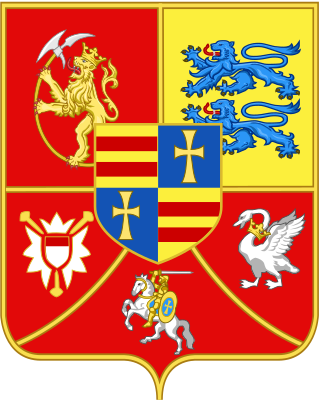
The House of Romanov was the reigning imperial house of Russia from 1613 to 1917. They achieved prominence after the Tsarina, Anastasia Romanova, was married to the First Tsar of Russia, Ivan the Terrible. Czar Nicholas II's immediate family was executed in 1918, but there are still living descendants.

Peter III Fyodorovich was Emperor of Russia from 5 January 1762 until 9 July of the same year, when he was overthrown by his wife, Catherine II. He was born in the German city of Kiel as Charles Peter Ulrich of Schleswig-Holstein-Gottorp, but he was a grandson of Peter the Great and a great-grandson of Charles XI of Sweden.

The House of Glücksburg is a collateral branch of the German House of Oldenburg. Its members have reigned at various times in Denmark, Norway, Sweden, Iceland, Greece, and several northern German states.

Holstein-Gottorp or Schleswig-Holstein-Gottorp is the historiographical name, as well as contemporary shorthand name, for the parts of the duchies of Schleswig and Holstein, also known as Ducal Holstein, that were ruled by the dukes of Schleswig-Holstein-Gottorp, a side branch of the elder Danish line of the House of Oldenburg. Other parts of the duchies were ruled by the kings of Denmark.

The House of Oldenburg is a German dynasty with links to Denmark since the 15th century. It has had branches that rule or have ruled in Denmark, Iceland, Greece, Norway, Russia, Sweden, the United Kingdom, Schleswig, Holstein, and Oldenburg. The current Queen of Denmark, King of Norway and King of the United Kingdom are all patrilineal descendants of the Glücksburg branch of this house.

Charles Frederick, Duke of Schleswig-Holstein-Gottorp was a Prince of Sweden and Duke of Schleswig-Holstein-Gottorp and an important member of European royalty. His dynasty, the Dukes of Schleswig-Holstein-Gottorp, were a cadet branch of the ancient House of Oldenburg, which at that time was ruling Denmark-Norway. His mother was a sister of Charles XII of Sweden. Charles Frederick married a daughter of Peter the Great and became the father of the future Peter III of Russia. As such, he is the progenitor of the Russian imperial house of Holstein-Gottorp-Romanov and the patrilineal ancestor of all Russian emperors starting with Peter III, except for Catherine II.

Grand Duchess Anna Petrovna of Russia was the eldest daughter of Emperor Peter I of Russia and his wife Empress Catherine I. Her younger sister, Empress Elizabeth, ruled between 1741 and 1762. While a potential heir in the reign of her nephew Peter II, she never acceded to the throne due to political reasons. However, her son Peter III became Emperor in 1762, succeeding Elizabeth. She was the Duchess Consort of Holstein-Gottorp by marriage. She was born in Moscow and died in Kiel in her youth, at the age of 20.

Duchess Marie Elisabeth of Saxony was duchess consort of Holstein-Gottorp as the spouse of Duke Friedrich III of Holstein-Gottorp. As a widow, she became known as a patron of culture.

Friedrich August, Duke of Holstein-Oldenburg was the son of Christian August, regent of Holstein-Gottorp and his wife Margravine Albertine Friederike of Baden-Durlach.

The attempt to create a Kingdom of Finland in 1742 is a little-known chapter in the history of Finland. After the Russian occupation during the Russo-Swedish War (1741–1743) and vague promises of making Finland independent, Finns elected the Duke Peter of Holstein-Gottorp, who later became heir to the throne of Russia and Emperor as Peter III, as the King of Finland. However, the political situation had outgrown the idea of Finnish independence, which quickly evaporated.

Joanna Elisabeth of Holstein-Gottorp was a member of the German House of Holstein-Gottorp, a princess consort of Anhalt-Zerbst by marriage, and the regent of Anhalt-Zerbst from 1747 to 1752 on behalf of her minor son, Frederick Augustus. She is best known as the mother of Empress Catherine the Great of Russia.
Holstein-Glückstadt or Schleswig-Holstein-Glückstadt is the historiographical name, as well as contemporary shorthand name, for the parts of the duchies of Schleswig and Holstein that were ruled by the Kings of Denmark in their function as dukes of Schleswig and Holstein, thus also known as Royal Schleswig-Holstein. Other parts of the duchies were ruled by the Dukes of Schleswig-Holstein-Gottorp. The territories of Holstein-Glückstadt are located in present-day Denmark and Germany. The main centre of administration was Segeberg and from 1648 Glückstadt on the River Elbe.

Duchess Therese Wilhelmine Olga Friederike of Oldenburg was the youngest daughter of Duke Peter Georgievich of Oldenburg and his wife Princess Therese of Nassau-Weilburg.

Princess Margravine Albertina Frederica of Baden-Durlach was a German princess. She was the daughter of Frederick VII, Margrave of Baden-Durlach and his wife Duchess Augusta Marie of Holstein-Gottorp. She married Christian August of Holstein-Gottorp, Prince of Eutin.

Magdalena Sibylle of Holstein-Gottorp was a Duchess of Holstein-Gottorp by birth and by marriage Duchess of Mecklenburg-Güstrow. From 1654 to 1695, she was the consort of Duke Gustav Adolph of Mecklenburg-Güstrow. She is also a direct female line ancestor to Queen Victoria.





























